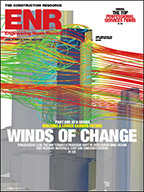Rhode Island wind developer Deepwater Wind plans to develop two, $1-billion offshore underwater transmission networks for moving up to 2,000 MW of offshore wind energy to southern New England and New York.
“A merchant transmission network would reduce the cost of servicing the wind farm by providing multiple points of interconnection,” says Bill Moore, CEO of Deepwater Wind, Providence, R.I. “By combining a utility-scale offshore wind farm with a regional transmission network, we can deliver firm power to address the area's electricity demand.”
The submarine transmission lines are part of Deepwater's overall plan to develop four wind farms in the northeast, including the 1,000-MW Deepwater Wind Energy Center in southern Rhode Island Sound, and the 1,000-MW Hudson Canyon Wind Farm in the New York Bight, southeast of New York City. Deepwater also is one of eight firms bidding for commercial leasing in federal waters off Rhode Island and Massachusetts.
Each of the two planned transmission networks will use existing interconnection points that Deepwater has established in coastal New Jersey, New York City, Long Island and southern New England. Unlike a proposed $5-billion, 350-mile trunk line being developed by Bethesda, Md.-based Trans-Elect and intended to interconnect multiple offshore wind farms, Deepwater's proposed transmission networks would tie into multiple grid locations that each can accommodate up to 600 MW of new electricity generation without system upgrades, Moore says.
The line will be interconnected with generation sources onshore that will integrate the wind power and allow Deepwater Wind to supply New York with firm power, Moore says.
In New York, Deepwater's proposed high-voltage line is now under study by the New York Independent System Operator and the PJM Interconnection, the regional transmission organization. Construction on the 100-mile-long line in Rhode Island would begin in 2014; construction on the New York line would follow, Moore says.



